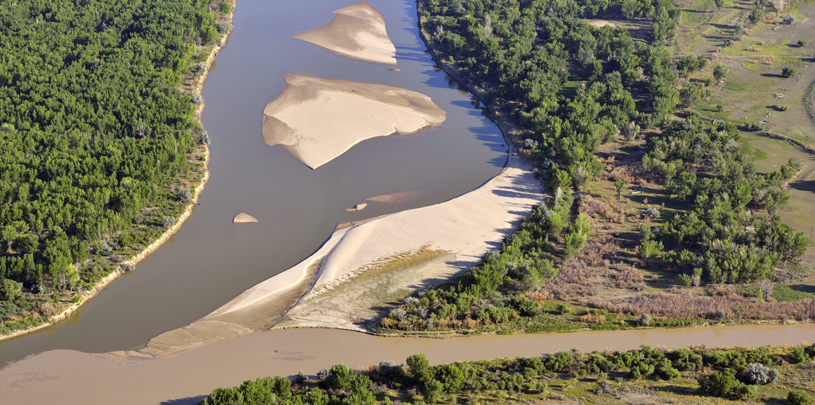
 by Anne Mariah Tapp, Energy Director
by Anne Mariah Tapp, Energy Director
Here at the Grand Canyon Trust, we look for ways forward through charged issues like grazing, forestry, and clean energy. But there are times when environmental concerns, economics, and common sense dictate that we must draw a line in the sand.
Strip mining the iconic landscapes of northern Utah for tar sands and oil shale — two of the world’s dirtiest fuels — is one of the worst ideas that we’ve seen in a while, both for the land, and for the communities whose air quality and water resources hang in the balance. And to make it even worse, the Bureau of Land Management (BLM) is botching the environmental review analysis for the very first commercial oil shale project proposed in the Colorado River Basin, allowing the oil shale industry to game the very system designed to protect our environment.
As we wrote a few weeks ago, Enefit American Oil is currently asking the BLM to allow free use of American public land to run a massive utility corridor to get its oil shale strip mine and power plant up and running. We’ve looked at the project and are drawing our line in the sand. We are saying no blank checks for dirty oil shale.
Here’s why we think Enefit’s oil shale project is a bad deal for Utah:

Sunset in Bonanza, Utah. PHOTO: MICHAEL COLLIER.
Air quality in the Uinta Basin and Salt Lake City region is among the worst in the nation. A 2016 American Lung Association report ranked Salt Lake City's air quality the sixth worst in the U.S. Enefit’s project will add to emissions, including ground-level ozone in the Uinta Basin. Additionally, oil produced at Enefit’s project will be shipped to refineries in Salt Lake City, exacerbating air quality issues in the area.
According to Enefit’s own estimates, greenhouse gas emissions from oil shale extraction would be 40% higher than conventional oil extraction. Given the U.S. commitment to lower carbon emissions in recognition of the climate crisis, the BLM must reject Enefit’s proposal and the use of American public lands to effectively subsidize air-polluting oil shale.
Enefit won’t definitively say how much water it needs for its mining operations or power plant, or where it will get it. According to the draft environmental impact statement prepared by the BLM, the company may use water from the Green River, may take water from the White River, and/or may use groundwater. In terms of quantity, the BLM has left the door open for Enefit to supplement its current 15 cubic-feet-per-second water right (nearly 10 million gallons per day) if it decides it needs more Colorado River Basin water.
Enefit has also failed to disclose or analyze potential contamination of groundwater resources due to oil shale leaching. In Estonia, huge heaps of oil shale mining waste produced by Enefit’s operations are nicknamed the “Estonian Alps,” and are visible from space. Oil shale waste has polluted vast amounts of groundwater in Estonia, rendering entire landscapes uninhabitable. We believe that the company must clearly identify all impacts to all water resources in the project area. Unless and until the company can provide such information—and get its water story straight—the permits should not be granted.
Enefit is attempting to game the environmental review system designed to protect water, air, land, wildlife, and human health. Enefit says it needs the utility corridor across federal land in order to develop of its massive strip mining and power plant operation. But the company refuses to provide a specific development plan for its project, claiming it has to wait until the BLM grants the utility corridor. Part of the BLM’s job is to determine whether the project is in the public interest. But because Enefit is hiding the ball, the BLM can’t assess the mining project’s impacts to air, water, the climate, or endangered species. As a result, it can’t determine whether the project is or isn’t in the public interest. At minimum, the BLM should delay its decision on the rights-of-way needed for the utility corridor until it is able to meaningfully analyze the impacts of the oil shale strip mine and power plant – the reason the rights-of-way across American public land are being requested in the first place.

The endangered bonytail chub. PHOTO: MICHAEL COLLIER.
Endangered and fragile species — from birds, to fish, to rare wildflowers — live in the area that Enefit is attempting to strip mine and pollute. These species include the greater sage-grouse, Mexican spotted owl, yellow-billed cuckoo, bonytail chub, Colorado pikeminnow, greenback cutthroat trout, humpback chub, razorback sucker, blackfooted ferret, clay reed-mustard, Graham beardtongue, Pariette cactus, shrubby reed-mustard, Barneby reed mustard, Uintah Basin hookless cactus, Ute ladies’-tresses, and White River beardtongue. Strip mining would be devastating to these precious species, particularly the plants that thrive in shaley soil. And taking water out of the Green and White rivers will impact fish populations.
Estonian-owned oil shale giant is barred from siphoning 100 billion gallons of water from a Colorado River tributary.
Read MoreThere's something fishy about the water right for a massive oil shale facility in northern Utah.
Read MoreCould a wild corner of Utah become the site of the nation's first commercial-scale oil shale strip mine and processing plant?
Read More